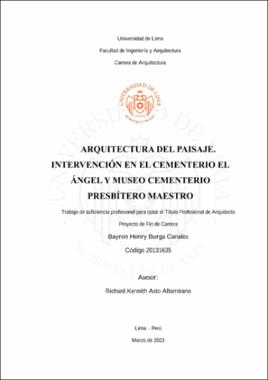Arquitectura del paisaje. Intervención en el Cementerio El Ángel y Museo Cementerio Presbítero Maestro

View/
Trabajo
(application/pdf: 26.37Mb)
(application/pdf: 26.37Mb)
Autorización
(application/pdf: 927.6Kb)
(application/pdf: 927.6Kb)
Reporte de similitud
(application/pdf: 19.22Mb)
(application/pdf: 19.22Mb)
Date
2023Author(s)
Advisor(s)
Metadata
Show full item recordAbstract
Cemeteries are spaces where citizens interact with the past. The memory, the senses and the emotions that are manifested within these environments have made the link with the cemeteries special and different from other buildings. Since its inception, cemeteries have been moved out of cities for health reasons. However, the lack of planning led to a disorderly growth of cities, urban cemeteries were encapsulated and isolated within it. These cemeteries are crowded, at present, and in most cases, they are unused. Despite this, many buildings of historical and artistic value are located inside, which accumulated throughout its evolution. The disorderly growth and the deficit of public space have prompted the search for new strategies to obtain space for recreation and green areas. One of the most successful is the recycling of unused equipment. This "recycling" of equipment and the new ways of thinking about death and burial have influenced the vision of cemeteries. This new current, of European origin, proposes cemeteries as public spaces for enjoyment due to their accessibility and large extensions of green areas and trees without losing their identity as historical infrastructure of the city. This type of cemeteries is being accepted internationally and is already present in some Latin American countries. In the national context, the urban cemeteries of the city of Lima (such as the Cementerio El Ángel and the Museo Cementerio Presbítero Maestro) have the potential to develop as new typologies of natural spaces through urban strategies around the landscape, edges and walking trails. Los cementerios son espacios donde los ciudadanos interactuamos con el pasado. La memoria, los sentidos y las emociones que se manifiestan dentro de estos ambientes han hecho que el vínculo con los camposantos sea especial y diferente respecto a otras edificaciones. Desde su inicio, los cementerios fueron desplazados hacia afuera de las ciudades por motivos de salud. Sin embargo, la falta de planificación desemboco en un crecimiento desordenado de las ciudades, los cementerios urbanos quedaron encapsulados y aislados dentro de este. Estos cementerios están copados, en la actualidad, y en la mayoría de los casos están sin uso. A pesar de esto, al interior se ubican gran cantidad de construcciones de valor histórico y artístico que fueron acumulándose a lo largo de su evolución. El crecimiento desordenado y el déficit de espacio público han impulsado en la búsqueda de nuevas estrategias de obtener espacio para la recreación y áreas verdes. Una de las más exitosas es el reciclaje de equipamientos sin uso. Este “reciclaje” de equipamientos y las nuevas formas de pensamiento sobre la muerte y la sepultura influyeron en la visión que se tiene sobre los cementerios. Esta nueva corriente, de origen europeo, propone a los cementerios como espacios públicos para el disfrute por su accesibilidad y grandes extensiones de áreas verdes y arbolado sin perder su identidad como infraestructura histórica de la ciudad. Este tipo de cementerios está siendo aceptado internacionalmente y ya se encuentra presente en algunos países de Latinoamérica. En el contexto nacional, los cementerios urbanos de la ciudad de Lima (como el cementerio El Ángel y el Museo Cementerio Presbítero Matías Maestro) tienen el potencial para desarrollase como nuevas tipologías de espacios naturales a través de estrategias urbanas en torno al paisaje, bordes y senderos
How to cite
Burga Canales, B. H. (2023). Arquitectura del paisaje. Intervención en el Cementerio El Ángel y Museo Cementerio Presbítero Maestro [Trabajo de suficiencia profesional para optar el Título Profesional de Arquitecto, Universidad de Lima]. Repositorio Institucional de la Universidad de Lima. https://hdl.handle.net/20.500.12724/18179Publisher
Universidad de LimaSubject
Collections
The following license files are associated with this item:

